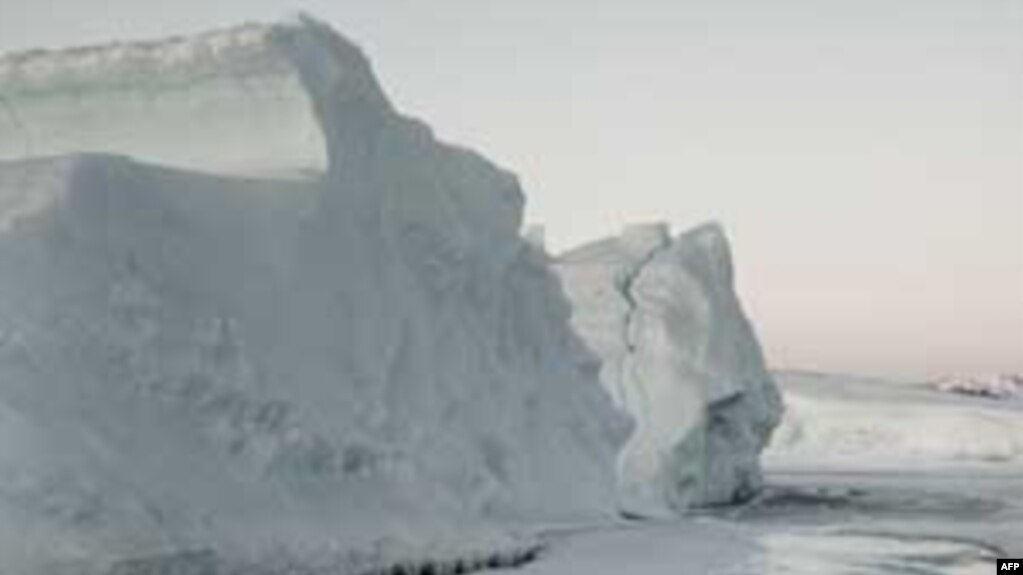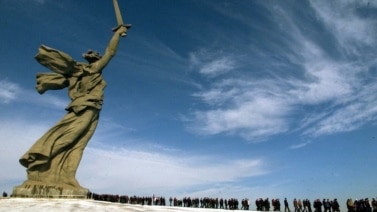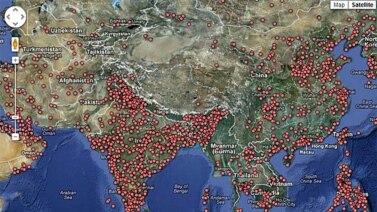
From VOA Learning English, welcome to As It Is.
I’m Caty Weaver. On today’s show we talk about the moon and sleep, as well as pesticides in Pacific chorus frogs. But we first look at what could be the price of a melting Arctic.
Arctic Permafrost May Release Costly Methane
Experts believe there are huge amounts of gas and oil in the Arctic. For some years, industries have looked at the ongoing Arctic ice melt as a source of possible profits from those natural resources. But researchers say methane gas will escape in amounts not seen before as the permafrost melts. And that, scientists say, could cost the world trillions of dollars. Kelly Jean Kelly reports.
Researchers from Britain’s University of Cambridge and the Netherlands’ Erasmus University Rotterdam looked at studies of methane gas releases in the East Siberian Sea. They estimated that the release of 50 billion tons of methane over ten years could result in a 60 trillion dollar economic loss. The size of the total world economy is currently about 70 trillion.
Chris Hope of the University of Cambridge is an expert in the economics of climate change. He co-wrote the report.
“The impacts will be felt about 80 percent in developing countries and only about 20 percent in the countries like the U.S. and the European Union which are rather better off.”
For example, he says, productive farming may become impossible in parts of sub-Saharan Africa where production is already low. And, he says, rising sea levels and increasing storms could cause destruction in places like Bangladesh.
The commentary calls for such costly possibilities to be considered when governments and industries explore Arctic development. Chris Hope says in the past people have expected good things to come from Arctic ice melt. This included increased shipping through the area and more exploration for resources. But Mr. Hope warns the bad will outweigh the good.
“People have said there might well be some billions of dollars’ worth of benefit from that. What we are saying is ‘yes, that may be true,’ but the negative effects, the extra economic impacts around the world, will not just be billions of dollars they are likely to be tens of trillions of dollars.”
Co-author Peter Wadhams is the leader of the polar ocean physics group at University of Cambridge. He says the release of methane could be disastrous. He says the powerful greenhouse gas is responsible for 25 percent of global warming. Yet, he says, there is little that can be done right now to prevent the methane leaks.
Mr. Wadhams says government and international groups should be investing money and resources toward finding a solution. He says scientists are a long way from there.
I’m Kelly Jean Kelly.
Pesticides Climing Mountains?
Northern California’s national parks appear pure and clean, almost untouched. But scientists are finding that there is more to this wild area than one can see. Even in the deep forests and on the mountain tops, animals may be poisoned by pesticides used in valley farms far below. Mario Ritter has more.
Researchers with the United States Geological Survey are working late into the night. They are searching for and capturing frogs in the mountains of the Sierra Nevada.
“The Pacific chorus frog breeds in the high mountains just as the snow melts. The pools basically fill with snow melt water, and as soon as the ponds thaw out the chorus frogs begin breeding there.”

That is Gary Fellers, a researcher emeritus with the USGS. He and other team members are collecting the frogs to test them for agricultural poisons. No one farms in these forested national parks. However, winds carry chemicals from the Central Valley farming area into the mountains.
Kelly Smalling was the lead writer of the USGS study.
“The decline of amphibians has been documented for decades and decades, we know that amphibian populations are declining. Some populations have gone extinct. And why these populations are declining is still a mystery.”
Ms. Smalling says pesticides could be harming frogs, and other amphibians.
The researchers tested pond water and soil from the bottom of the ponds. They were clean or almost clean of pesticides. But tests on the bodies of the frogs showed the presence of 12 agricultural pesticides. Again, Gary Fellers.
“The concentration in the frog becomes greater than the concentration that is present in the water or the sediment, or some other part of the environment.”
Kelly Smalling says the next step is finding a way to deal with the contamination.
“The first thing we need to do is understand how these chemicals that we’re finding impact the frogs.
Ms. Smalling says we have to understand the problem before we can fix it.
I’m Mario Ritter.
Sleep Under a Full Moon
Finally, do you ever have trouble falling asleep? Next time it happens take a look at the night sky. Is the moon full? Some Swiss scientists say that may be the problem.
Researchers at the Psychiatric Hospital of the University of Basel examined sleep measurements, including brain activity, taken at a sleep clinic. Thirty-three people took part in the study. The researchers found that the people slept more poorly when the moon was full.
Christian Cajochen was the lead investigator.
“Around full moon, people had less deep sleep, about 30 percent less deep sleep. They slept in general 20 minutes shorter and it took them five minutes longer to fall asleep.”

The researcher says little is known about the effects of moon activity on humans. Sleep is influenced by a 24-hour body clock called a circadian rhythm. It is driven by the release of chemicals in the body called hormones. The scientists found that the people who took part in the study had lower amounts of the sleep hormone melatonin during a full moon.
The scientists noted that full moons were also linked to an increase in howling.
Just kidding about that part.
I’m Caty Weaver.
And that’s AS IT IS for today. Thanks for joining us. Visit our website at learningenglish.voanews.com where you can find audio and pdf files for download. You can also leave a comment for us about this show or any of our programs.





